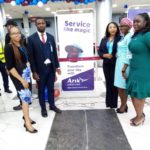
The federal government has started the restoration of aeronautical facilities and the installation of Category 3 Instrument Landing System (ILS) at airports and other strategic locations in the country in order to improve safety of flight operations, Managing Director of the Nigerian Airspace Management Agency (NAMA), Captain Fola Akinkuotu, has confirmed to THISDAY in Lagos.
He said the government was determined to sustain the record of no-air accident involving commercial aircraft since 2013 and also make flight operations in Nigeria’s airspace safer.
Akinkuotu said with the improvement of effective radar coverage of the airspace, airlines have reduced their flight time by at least five minutes to many local destinations, which has saved them about N542 million monthly on fuel consumption, translating to about N18 million daily for about 40 planes operating domestic flights.
The NAMA boss said this was made possible by radar capabilities, known as radar vectoring assistance and the equipment is currently very efficient because of its upgrade and top-notch maintenance.
He added that NAMA has completed plans to end flight delays and cancellations this year due to the inclement harmattan weather by installing Category 3 Instrument Landing System (ILS) at the Nnamdi Azikiwe International Airport, Abuja and the Murtala Muhammed International Airport (MMIA), Lagos before the end of November.
According to him, this would end the loss of revenue put at millions of naira by the airlines, which are forced to cancel flights during the peak Christmas seasons due to low visibility occasioned by the harmattan.
Akinkuotu, who said that the number of operating commercial aircraft has increased to 40, added that NAMA is helping the airlines to save money on aviation fuel and has also significantly improved radio communication in the airspace.
“Our radar (Total Radar Coverage of Nigeria) is working efficiently. When we came in, the radar had degenerated because there were issues between NAMA and Thales of France, which built the radar, but when we came in we rebuilt the relationship and since then the company has been supplying us the needed spares; so, the radar enjoys top-notch maintenance now.
“With radar vectoring assistance, Nigerian airlines are saving fuel through reduced flight time. At least there is reduction of flight time by five minutes. In five minutes, an average Boeing 737 consumes about 291 litres of fuel -aircraft type consumes maximum of 3,500 litres in one hour. At the price of N250 per litre, if we conservatively say that every aircraft operates only six times daily and multiply it with the 40 aircraft that are currently in operation, that gives about N523, 800,000. This means that the more flights you do, the more you save. This saved funds are very important for airlines that operate largely on marginal gains,” Akinkuotu stated.
The NAMA boss said the agency also introduced electronics flight, which makes it easier for airlines registered to file the flight plan electronically and has also boost radio communication in the airspace.
“As far as the radio is concerned we have improved communication in the airspace. Recently, we got Jos back and also Maiduguri; so, the two airports have improved communication. The ILS Category 3 is here and we will start installing them this October. We are only waiting for the rains to end. We are working hard to make sure that by November we have completed their installation at the two airports in Abuja and Lagos.
“We are also working on Aeronautical Information Service (AIS), which is to ensure the flow of information necessary for safety, regularity and efficiency for international air navigation and we hope to complete the project by end of this year or first quarter of next year. We are making very good progress. The Lagos equipment is completed and we are installing in six other places,” Akinkuotu said.
He added that the agency has advanced in migrating to satellite based navigation to make it easier for flight movement in Nigeria’s airspace.
“We are migrating from ground-based navigation to satellite-based navigation. We have performance-based navigation, which is defined in terms of accuracy, integrity, availability, continuity, and functionality. NAMA has installed this system, which airlines that have corresponding equipment are benefitting from. The Category 3 ILS will enable aircraft to land during the peak of harmattan because of its accuracy. It brings the aircraft down to five feet to the ground.
“NAMA recently installed Category 2 ILS at the Benin airport. Satellite -based navigation will bridge communication gaps experienced in the past and also enhance navigation accuracy. NAMA has installed approach facilities in 28 airports and has continued to improve navigation in the airspace,” he said.
THISDAY






